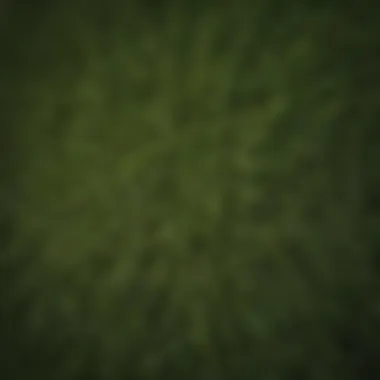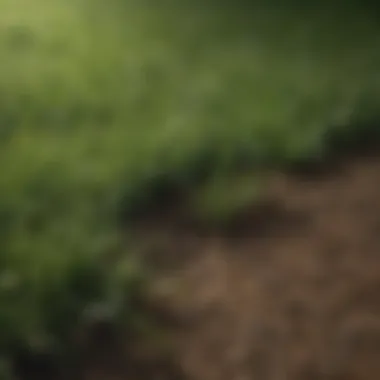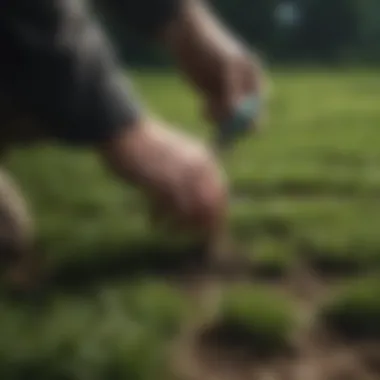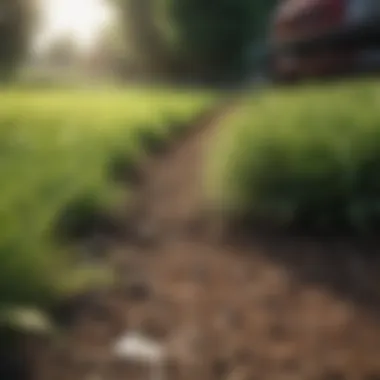Expert Tips on Selecting the Best Top Dressing for Grass Seed Growth


Interior Design Tips
Selecting the ideal top dressing for grass seed plays a crucial role in nurturing a healthy and vibrant lawn. Homeowners and gardening enthusiasts keen on enhancing their grass's growth can benefit from a detailed understanding of the various top dressing types and application methods. Let's delve into the nuances of selecting the best top dressing for grass seed to achieve a lush and thriving lawn.
Exploring Top Dressing Types
When it comes to top dressing for grass seed, there are several options available, including organic top dressing, compost, sand, or a mix of these materials. Each type has distinct characteristics that influence its effectiveness in promoting grass growth and maintaining soil health.
Organic top dressing enriches the soil with nutrients, while sand aids in improving soil structure and drainage.
Application Methods
Proper application of top dressing is vital for ensuring its efficacy in supporting grass seed growth. Depending on the chosen top dressing type, methods such as top dressing with compost spreaders, hand application, or professional services may be more suitable. Understanding the intricacies of each application method can help in achieving optimal results.
- Hand Application: Suitable for small areas, this method involves spreading top dressing by hand evenly.
- Compost Spreaders: Ideal for larger areas, compost spreaders ensure uniform distribution of top dressing.
Key Considerations
Before selecting a top dressing for grass seed, consider factors such as grass type, soil composition, and specific lawn requirements. Conducting a soil test can provide valuable insights into the soil's pH levels, nutrient deficiencies, and texture, guiding you in choosing the most suitable top dressing for optimal grass growth.
For further information on soil testing, refer to Wikipedia and Britannica, which offer detailed insights into the importance of soil analysis in lawn care.
Understanding the Importance of Top Dressing
Top dressing plays a pivotal role in nurturing a healthy and vibrant lawn by replenishing nutrients and improving soil structure. The benefits of top dressing are multifaceted, ranging from enhanced soil nutrition to promoting robust grass root development and smoothing out uneven terrain. Investing time and effort into understanding the significance of top dressing is fundamental to achieving a lush and flourishing lawn.
Benefits of Top Dressing
- Enhanced soil nutrition: Enhanced soil nutrition infuses essential elements into the soil, providing a fertile environment for grass growth. Organic matter and nutrient-rich components enrich the soil, fostering optimal conditions for grass vitality. Choosing the right soil amendments can significantly impact the overall health of your grass lawn.
- Improved grass root development: Improved grass root development is fundamental for the longevity and strength of your lawn. Deep and well-established roots ensure efficient water and nutrient uptake, contributing to the resilience and durability of the grass. By prioritizing improved root development, homeowners can pave the way for a robust and enduring lawn structure.
- Smoothing uneven terrain: Smoothing uneven terrain through top dressing levels out bumps and depressions, providing a more aesthetically pleasing and functional lawn. This process enhances surface uniformity, making mowing and maintenance tasks more manageable. Homeowners can create a visually appealing landscape while also facilitating better grass growth across the entire lawn. I hope this detailed narrative provides valuable insights for homeowners, gardening enthusiasts, or anyone seeking to elevate the health and appearance of their grass lawn.
Types of Top Dressing Materials
Choosing the right top dressing material is crucial for the health and vitality of your grass seed. Top dressing materials play a pivotal role in providing essential nutrients, improving soil structure, and promoting healthy grass growth. Understanding the various types of top dressing materials available can help you make an informed decision to achieve a lush and vibrant lawn.
Compost
Organic Matter
Organic matter is a fundamental component of compost top dressing. Its rich composition of decayed organic materials like leaves, grass clippings, and kitchen scraps enhances soil fertility and promotes beneficial microbial activity. The organic matter in compost improves soil structure, water retention, and nutrient availability, making it an optimal choice for sustainable gardening practices. Utilizing compost as a top dressing material introduces a natural and nutrient-rich element to nourish your grass seed, fostering robust growth and resilience.
Nutrient-rich
Compost is lauded for its nutrient-rich profile, supplying essential macronutrients and micronutrients vital for plant growth. The diverse array of nutrients available in compost, such as nitrogen, phosphorus, and potassium, ensures a well-balanced diet for your grass seed. The nutrient-rich nature of compost boosts soil fertility, aids in chlorophyll production, and fortifies grass against environmental stressors. Incorporating compost as a top dressing material enriches the soil, fostering vigorous root development and vibrant foliage.


Topsoil
Rich in Minerals
Topsoil is revered for its mineral-rich composition, delivering vital nutrients like calcium, magnesium, and sulfur essential for plant health. The abundance of minerals in topsoil benefits grass growth by supporting metabolic processes, enhancing nutrient absorption, and strengthening cell walls. The mineral content of topsoil optimizes soil pH levels, promotes enzymatic functions, and fortifies grass resilience against disease and pests. Utilizing topsoil as a top dressing material instills a mineral boost in the soil, fostering robust growth and optimal nutrient uptake.
Improves Soil Structure
The capacity of topsoil to improve soil structure is a key attribute that enhances aeration, drainage, and root penetration. Its finely textured composition aids in aggregating soil particles, reducing compaction, and increasing water infiltration. The improved soil structure facilitated by topsoil promotes beneficial microbial activity, root growth, and nutrient circulation. Integrating topsoil as a top dressing material transforms the soil environment into a fertile and hospitable medium for grass seed, ensuring sustained growth and vitality.
Peat Moss
Retains Moisture
Peat moss is renowned for its moisture-retentive properties, locking in hydration and preventing moisture loss in the soil. The water-absorbing capacity of peat moss ensures consistent moisture levels essential for seed germination, root establishment, and overall plant hydration. Its ability to retain moisture mitigates water stress, sustains lush foliage, and facilitates nutrient uptake. Incorporating peat moss as a top dressing material enhances water management in the soil, promoting uniform growth and sustained hydration for your grass seed.
Acidic Properties
The acidic properties of peat moss contribute to pH regulation in the soil, creating an acidic environment conducive for certain plant species. Its ability to lower soil pH levels benefits acid-loving plants, such as azaleas and blueberries, by providing an optimal growing medium. The acidic nature of peat moss deters alkaline soil conditions, supports nutrient availability, and fosters root development. Utilizing peat moss as a top dressing material is ideal for acidifying soil and cultivating specific plant varieties that thrive in acidic environments.
Factors to Consider When Choosing Top Dressing
When selecting the ideal top dressing for grass seed, various factors demand careful consideration. It is crucial to understand how each element can impact the growth and vitality of your lawn significantly. By delving into the specifics of grass type, soil condition, and climate, homeowners and gardening enthusiasts can make informed decisions that will ultimately benefit their green spaces.
Grass Type
Cool-season grasses
Cool-season grasses play a pivotal role in the top dressing selection process. Their ability to thrive in cooler temperatures makes them a popular choice for many regions. With their inclination towards growth during the spring and fall, cool-season grasses offer a lush, vibrant lawn aesthetic. Homeowners seeking year-round greenery often opt for these grass types due to their durability and resilience in varying weather conditions.
Warm-season grasses
On the other hand, warm-season grasses bring a different set of advantages to the table. Thriving in hot climates, these grasses exhibit excellent heat tolerance and can withstand drought conditions. Their optimal growth occurs during the summer months, providing a verdant landscape when other grass types succumb to the heat. Although they may go dormant in colder seasons, warm-season grasses hold their own charm for those looking for low-maintenance yet visually appealing lawns.
Soil Condition
Loamy soil
Loamy soil stands out for its balanced composition, blending sand, silt, and clay in ideal proportions. This soil type offers excellent drainage properties while retaining essential moisture for plant roots. Home to thriving ecosystems, loamy soil serves as a fertile ground for promoting healthy root development and overall plant growth. Its versatility allows for versatile gardening options, making it a top choice for those looking to enhance the vitality of their grass through effective top dressing.
Clay soil
In comparison, clay soil presents a denser texture that can challenge gardeners. While clay soil retains moisture well, it may suffer from drainage issues, leading to waterlogging and root rot concerns. Despite these drawbacks, clay soil possesses rich nutrients beneficial for plant growth. By incorporating appropriate amendments and top dressing materials, homeowners can transform clay soil into a nurturing environment for their grass to flourish.
Sandy soil


Sandy soil offers a light and well-draining foundation that appeals to certain grass species. Its quick drainage capabilities ensure that water does not stagnate around roots, reducing the risk of water-related diseases. However, sandy soil demands more frequent watering and fertilization due to its lower nutrient retention capacity. With the right top dressing strategies, sandy soil can support the growth of specific grass types known for their adaptability to such soil conditions.
Climate
Moisture levels
The moisture levels in your area play a critical role in determining the most suitable top dressing for your grass seed. Regions with high moisture content may benefit from top dressings that aid in drainage and prevent waterlogging. In contrast, arid climates require top dressings that enhance water retention to sustain grass growth during dry spells. Understanding the moisture dynamics of your environment enables you to tailor your top dressing selection to ensure optimal grass health.
Temperature range
The temperature range of your locality influences the growth patterns of grass and, consequently, the choice of top dressing materials. Areas prone to extreme heat or cold necessitate top dressings that provide insulation and protection for grass roots. By selecting top dressing solutions tailored to your region's temperature fluctuations, you can safeguard your lawn against climatic challenges and promote consistent growth throughout the year.
Application Techniques for Top Dressing
In the realm of lawn care, the utilization of suitable application techniques for top dressing holds a paramount significance. The process of top dressing contributes directly to soil health and grass development, ensuring a vigorous and verdant lawn. By selecting the correct technique, homeowners and gardening enthusiasts can optimize the benefits of top dressing in nurturing their grass seeds for optimal growth and vibrancy.
Spreading Methods
Hand Spreading
Hand spreading, with its manual dispersal approach, offers a personalized touch to the application of top dressing. The key characteristic of hand spreading lies in its ability to provide precise control over the dispersion of top dressing material, allowing for targeted coverage in specific areas of the lawn. This method is a popular choice for its flexibility and the meticulous attention it allows towards problem areas that may require extra nourishment. While hand spreading may be time-consuming for sizable lawns, its advantage lies in the detailed care it offers, particularly in intricate landscapes or areas with restricted accessibility.
Mechanical Spreaders
Contrasting with hand spreading, mechanical spreaders introduce efficiency and uniformity to the application process. These devices excel at covering larger areas swiftly, ensuring consistent distribution of top dressing material across the lawn. The key characteristic of mechanical spreaders is their capacity to expedite the spreading process significantly, making them a practical choice for individuals managing extensive lawn spaces. However, mechanical spreaders may lack the nuanced touch of hand spreading, potentially leading to uneven application in intricate or irregularly shaped landscapes. Despite this, their efficiency and time-saving nature make them a popular option for many homeowners seeking a balanced approach to top dressing application.
Timing of Application
The timing of top dressing application plays a pivotal role in the overall success of lawn care maintenance. Understanding the significance of the seasonal variations and their impacts on grass growth is essential for guiding the decision of when to apply top dressing.
Spring
Spring emerges as a preferred period for top dressing application due to the favorable environmental conditions for grass growth. The key characteristic of spring application is the alignment with the natural awakening of grass from its dormant state, encouraging robust root development and early-season nourishment. This timing capitalizes on the active growth phase of grass, maximizing the assimilation of nutrients and promoting resilience against weed invasion. However, the disadvantage of spring application lies in the susceptibility to sudden temperature fluctuations and unpredictable weather patterns, necessitating vigilant monitoring to mitigate potential risks.
Fall
Conversely, fall presents another opportune moment for top dressing application, heralding the transition of grass into a dormant phase. The key characteristic of fall application centers on preparing the lawn for the dormancy period by fortifying its nutrient reserves and insulating roots against harsh winter conditions. This timing facilitates the retention of soil moisture and nutrients essential for sustained root health during the colder months. Despite its advantages, fall application demands attentiveness to avoid excessive build-up of top dressing material that might stifle grass growth, requiring judicious management of coverage depth for optimal results.
Depth of Coverage
Determining the appropriate depth of coverage during top dressing application is essential for nurturing healthy soil and promoting robust grass growth. Balancing the thickness of top dressing while avoiding suffocation of grass roots is crucial for maintaining a flourishing lawn.
Optimal Thickness


The optimal thickness of top dressing material ensures a sufficient supply of nutrients to support grass health without overwhelming the underlying soil structure. The key characteristic of optimal thickness lies in its ability to create a nurturing environment for grass roots to access essential nutrients while fostering soil aeration and microbial activity. This level of coverage promotes root penetration and growth, enhancing the overall vigor and resilience of the lawn. However, exceeding the recommended thickness may lead to nutrient imbalances and inhibit root development, underscoring the importance of precision in achieving the optimal coverage depth.
Avoiding Suffocation
In contrast, the risk of suffocating grass roots due to excessive top dressing poses a significant challenge in lawn maintenance. The key characteristic of avoiding suffocation focuses on preserving adequate oxygen flow to the roots and preventing compaction of the soil layers. This approach safeguards against the restriction of essential nutrients and water uptake by the grass, fostering a sustainable ecosystem within the soil matrix. Proper aeration and soil structure maintenance are critical considerations in mitigating the risks associated with suffocation, highlighting the need for strategic planning and attentive management in top dressing applications.
Maintaining Top Dressing After Application
When it comes to creating a lush and vibrant lawn, the work does not end once the top dressing is applied. The post-application phase, focusing on maintaining the top dressing, is crucial for the long-term health of your grass seed. It involves several key elements and considerations that directly impact the success of your lawn renovation project.
Watering
Even moisture distribution
Even moisture distribution plays a pivotal role in ensuring that every part of the lawn receives an adequate amount of water. This method helps prevent patchy growth and promotes a uniform appearance across the entire lawn. By providing consistent moisture, the grass roots can develop evenly, leading to a healthier and more visually appealing lawn.
In this article, even moisture distribution is highlighted due to its effectiveness in fostering optimal grass growth and vitality. Its unique feature lies in its ability to create a balanced environment for all areas of the lawn, promoting overall coherence in grass development. While it has clear advantages in promoting uniform growth and health, it also requires regular monitoring to avoid overwatering, which can lead to issues such as root rot.
Avoiding runoff
Avoiding runoff is another critical aspect of post-application maintenance. This process involves ensuring that water penetrates the soil effectively, reaching the grassroots without causing erosion or water wastage. By preventing runoff, you maximize the water's utility, promoting better absorption and utilization by the grass roots.
In this article, the focus on avoiding runoff is essential for sustaining the health and growth of the newly seeded grass. Its significance lies in preserving valuable nutrients and moisture within the soil, enriching the grass seed with essential resources for development. While highly beneficial, this method requires careful observation and adjustment to prevent waterlogging and nutrient leaching.
Monitoring Grass Growth
Recognizing signs of stress
Recognizing signs of stress in your grass is a vital part of maintaining its overall well-being. By identifying early indicators such as discoloration, wilting, or stunted growth, you can intervene promptly to address underlying issues and prevent further damage. This proactive approach enables you to address problems before they escalate, safeguarding the health and appearance of your lawn.
In this article, the emphasis on recognizing signs of stress underscores its pivotal role in grass care. Its unique feature lies in its ability to alert homeowners to potential issues that may compromise the lawn's vitality. While advantageous in promoting early intervention and tailored treatment, this aspect necessitates keen observation and knowledge of common stress signals.
Adjusting care routine
Adjusting your care routine based on the identified needs of your grass is crucial for fostering optimal growth and resilience. Tailoring watering schedules, mowing heights, and nutrient applications to suit your lawn's specific requirements can enhance its overall health and vigor. By adapting your care practices in response to your grass's condition, you can promote thriving growth and longevity.
In this article, the concept of adjusting care routine is paramount in maintaining a vibrant and healthy lawn. Its significance lies in its ability to fine-tune care practices to suit the grass seed's evolving needs. While advantageous for promoting customized care and sustainable growth, this approach demands attentiveness and flexibility in lawn maintenance.
Weed Control
Preventative measures
Implementing preventative measures is key to minimizing weed infestations and preserving the integrity of your lawn. By employing strategies such as proper watering, mowing, and fertilization techniques, you can create an unfavorable environment for weed growth, reducing the need for reactive interventions. Preventing weed establishment early on can save you time and effort in managing unwanted vegetation.
In this article, the emphasis on preventative measures highlights its proactive role in maintaining a weed-free lawn. Its unique feature lies in its capacity to preemptively address potential weed threats, mitigating their impact on grass health and aesthetic appeal. While advantageous for reducing herbicide dependency and promoting natural weed control methods, this approach requires consistent implementation and monitoring.
Spot treatments
Utilizing spot treatments for weed control targets isolated weed outbreaks without impacting the surrounding grass. This focused approach allows you to manage weeds effectively while protecting the overall health and appearance of your lawn. By addressing problematic areas individually, you can prevent weed proliferation and safeguard the beauty of your grass.
In this article, the focus on spot treatments underscores its precision in addressing weed issues with localized solutions. Its significance lies in its ability to target specific weed populations without harming surrounding vegetation. Although advantageous for maintaining a pristine lawn without widespread herbicide use, this method calls for careful application and monitoring to ensure targeted efficacy and minimal environmental impact.







